This San Marzano Tomato Sauce is made with simple, high-quality ingredients for a rich, authentic-tasting sauce that pairs well with all of your favorite Italian dishes. Quick and beginner-friendly, this easy homemade tomato sauce recipe will have you saying goodbye to the store-bought version forever.
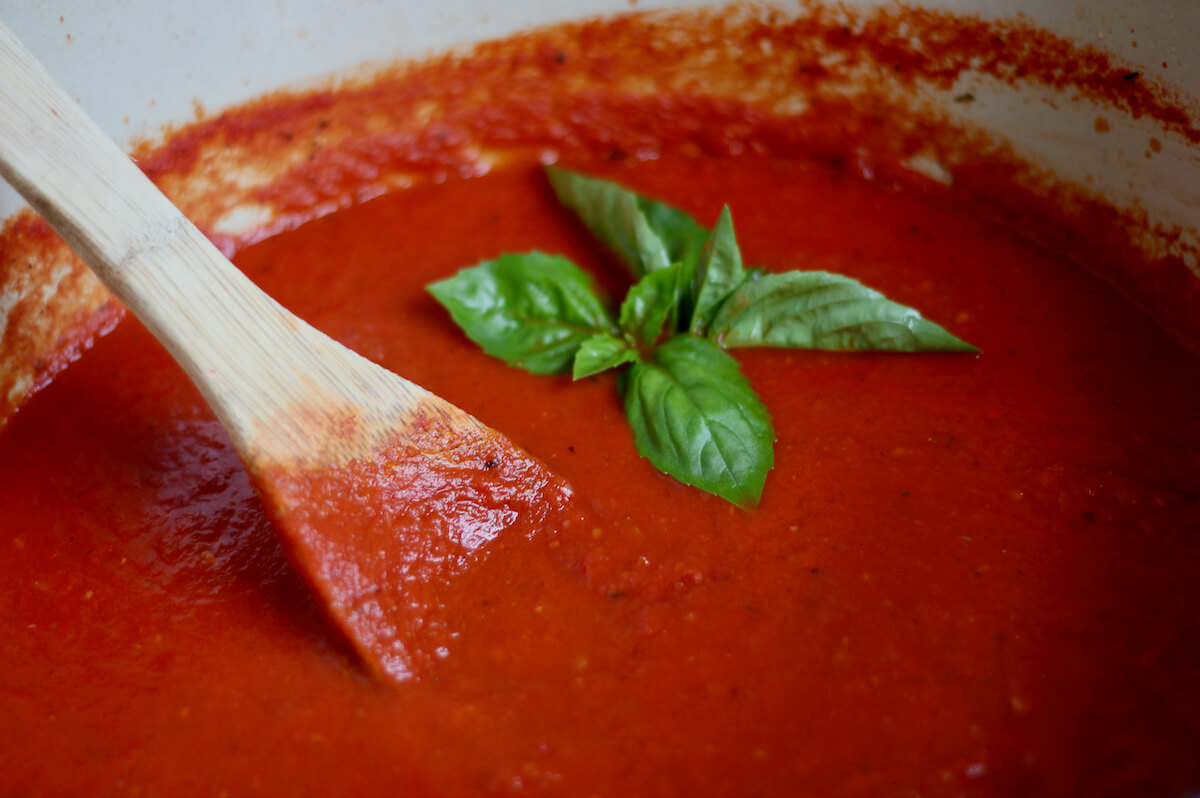
Making a simple homemade tomato sauce is a skill every home cook should master. Not only does homemade tomato sauce taste better than jarred sauce, but it also acts as the foundation for a variety of other recipes.
Whether you're cooking an easy weeknight pasta dish or perfecting Nonni’s scratch-made lasagna, having a go-to tomato sauce recipe up your sleeve is a must.
And this San Marzano tomato sauce recipe is mine.
I use this sauce to make everything from homemade pizzas and calzones to hearty meatballs and lasagna.
Today, I’m walking you through how to make the best San Marzano tomato sauce, including which ingredients to use, tips that will guarantee it turns out right the first time, and some of my favorite ways to use this basic Italian tomato sauce recipe.
Disclaimer: Some links throughout this post are affiliate links. As an Amazon Associate, I earn from qualifying purchases. You can learn more by visiting my Affiliate Disclosure Page.
What are San Marzano Tomatoes?
San Marzano tomatoes are unique plum tomatoes with thick flesh, fewer seeds, and a sweet flavor, making them perfect for a rich Italian sauce.
Authentic San Marzano tomatoes come only from the San Marzano region in Italy. They’re grown in Mount Vesuvius' volcanic soils in Southern Italy and bear the Denominazione d'Origine Protetta (D.O.P.) seal.
Look for "Pomodoro San Marzano dell’Agro Sarnese Nocerino D.O.P." on labels for genuine certification.
Why You'll Love This Recipe
- Authentic Flavor- San Marzano tomatoes give this simple marinara sauce an authentic Italian taste. The flavor is incomparable to jarred tomato sauce.
- Simple Ingredients- This easy San Marzano tomato sauce only requires 7 simple ingredients to make.
- Quick & Easy- In just 45 minutes, you can have delicious homemade tomato sauce on the table for your family to devour.
- Versatile- This versatile marinara sauce recipe can be used for pasta, meatballs, pizza, dipping, and more!
- Budget-Friendly- Save money by skipping expensive store-bought tomato sauces and make a large batch of homemade sauce to store in the freezer.
- Healthy- Many store-bought tomato sauces are made with added sugars, salt, and preservatives. By making tomato sauce from scratch, you can better control the ingredients you eat.
Ingredient Notes
Here are some notes on key ingredients. For a full list of ingredients, check out the recipe card below.
- San Marzano Tomatoes- San Marzano whole tomatoes are perfect for making tomato sauce because they’re less acidic and sweeter. Look for canned San Marzano tomatoes with the D.O.P. label for authenticity.
- Extra Virgin Olive Oil- Choose a high-quality extra virgin olive oil for the best, most authentic-tasting Italian red sauce.
- Onion- Yellow onion is milder in flavor compared to white or red onions, complementing the sauce without overpowering it.
- Garlic- Crushing the garlic cloves before mincing them helps release their flavor.
- Italian Seasoning- Italian seasoning is typically a blend of dried herbs like oregano, basil, thyme, marjoram, and rosemary. Sautéing the Italian seasoning in olive oil enhances its flavor.
- Red Pepper Flakes- A pinch of red pepper flakes adds a subtle heat to the sauce. Adjust the quantity based on your family's spice tolerance.
- Kosher Salt- Use kosher salt or sea salt for the best flavor. Table salt often contains added sugar and anti-caking agents.
🌱 Sustainability Tip: If you find yourself with leftover San Marzano sauce, don't let it go to waste! Freezing is an excellent way to preserve the sauce for later use.
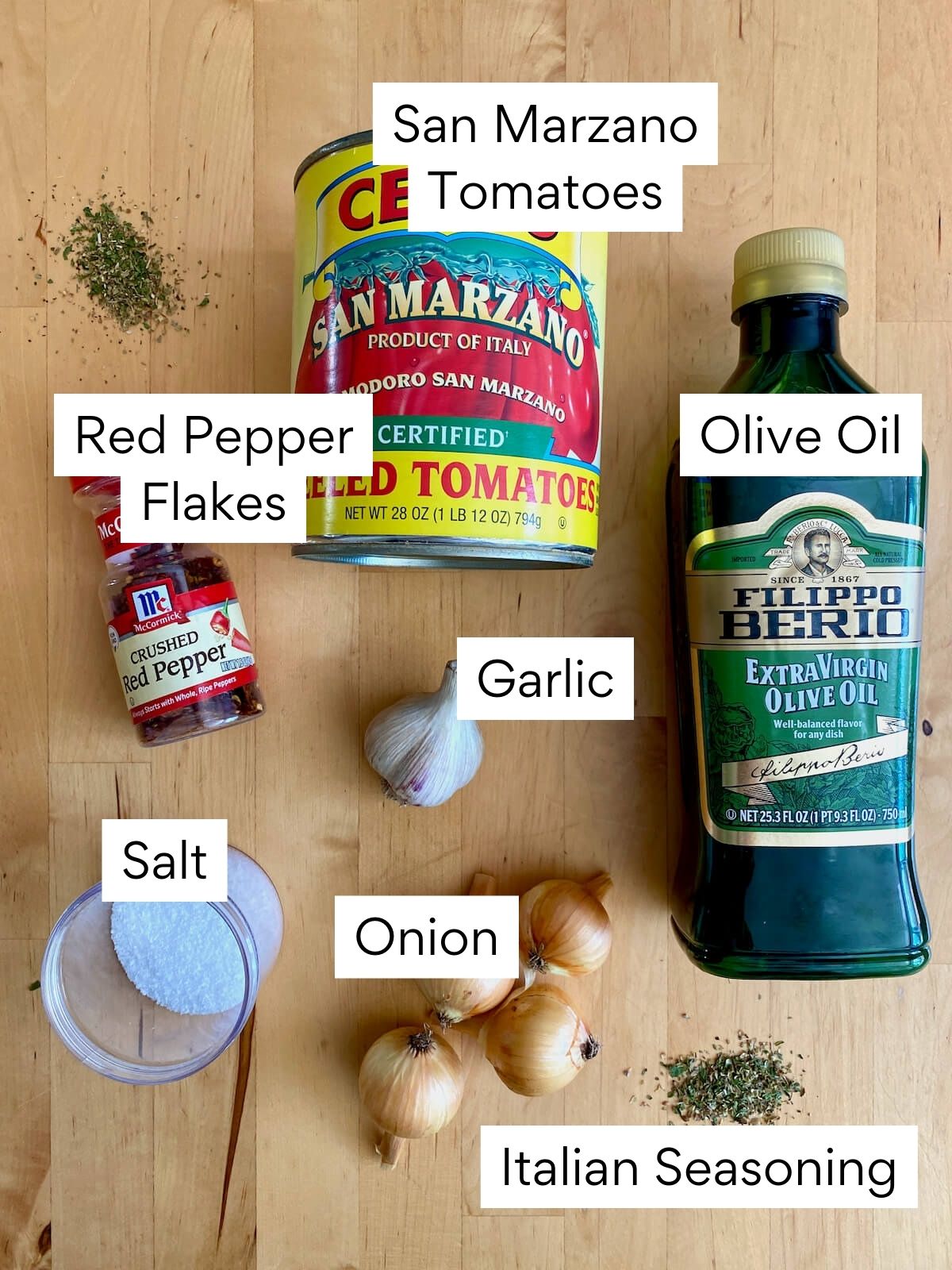
Substitutions and Variations
Here are a few ways you can try customizing this simple San Marzano tomato sauce recipe to fit your diet and taste preferences.
Substitutions
- San Marzano Tomatoes- Substitute San Marzano tomatoes for canned whole plum tomatoes or crushed tomatoes. Alternatively, use fresh San Marzano tomatoes if preferred.
- Extra Virgin Olive Oil- Use another neutral-flavored oil or unsalted butter in place of olive oil.
- Onion- Swap yellow onion for sweet onion, white onion, red onion, or shallots.
- Garlic- Substitute 4 cloves of garlic for one teaspoon of garlic powder. Garlic-infused olive oil is also a good substitute for fresh garlic.
- Italian Seasoning- Replace Italian seasoning with dried oregano or use a blend of dried basil, thyme, rosemary, and oregano. Alternatively, swap the dried herbs for fresh herbs if preferred.
- Red Pepper Flakes- Cayenne pepper, hot sauce, or freshly ground black pepper can be used in place of red pepper flakes.
- Kosher Salt- If using table salt, use half the amount called for in the recipe and adjust to taste from there.
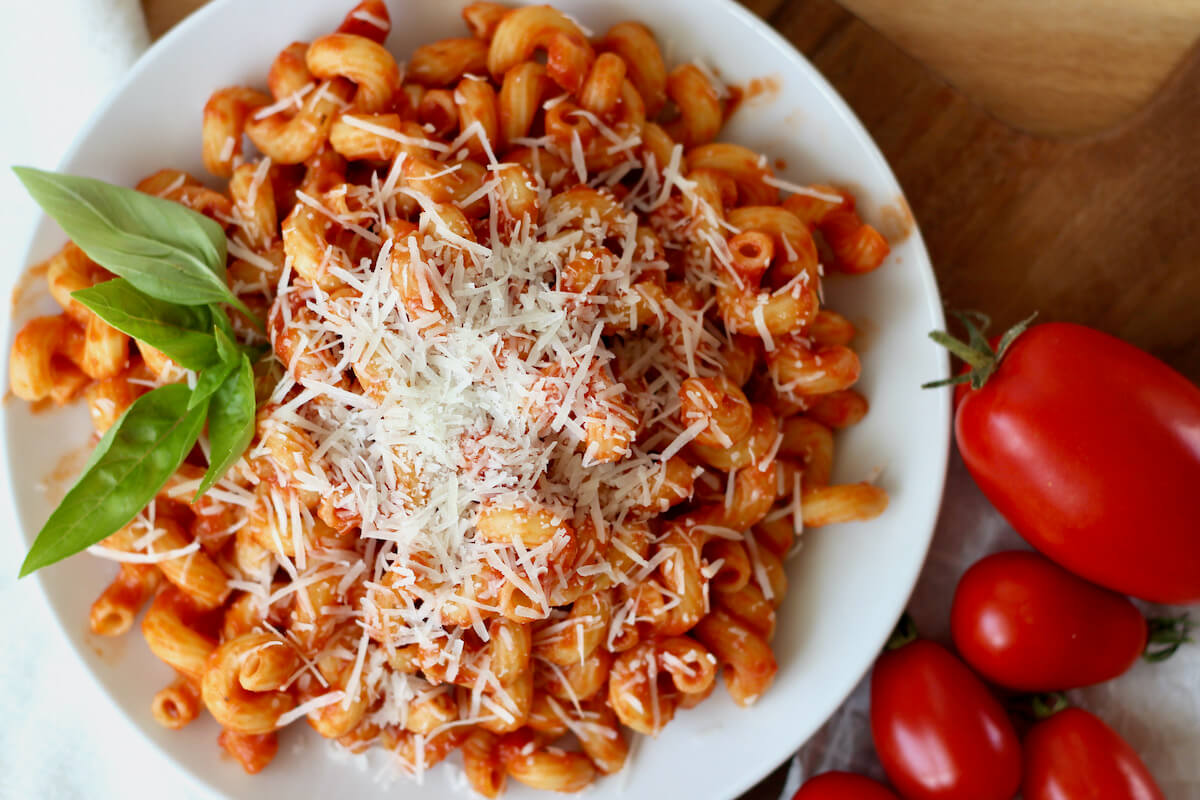
Variations
- Allergen-Friendly- This San Marzano sauce recipe is naturally gluten-free, dairy-free, egg-free, and vegan.
- Herbed- Simmer herbs like fresh basil, parsley, oregano, and thyme in the sauce while it cooks for a fragrant herb-infused tomato sauce.
- Wine- Add depth of flavor and complexity to this San Marzano tomato sauce with a splash of red wine or white wine to deglaze the pot.
- Meat- If you're looking to add some protein to your meal, consider including ground beef, pork, or turkey to create a flavorful meat sauce.
- Vegetables- Add some fresh veggies to your marinara sauce for a boost of nutrition. Try carrots, zucchini, mushrooms, bell peppers, eggplant, spinach, or kale.
- Tomato Paste- Add a tablespoon or two of tomato paste when sautéing the aromatics to give this sauce a richer tomato flavor.
- Creamy- Stir in a splash of heavy cream to finish the sauce and give it a rich and creamy flavor.
- Spicy- Increase the red pepper flakes to make spicy marinara sauce.
Equipment Notes
Here are some notes on any special equipment I used to make this recipe.
- Stainless Steel or Dutch Oven Pot- Use a heavy-bottomed stainless steel pot or Dutch oven for even heat distribution, which prevents the sauce from scorching.
- Immersion Blender- An immersion blender simplifies the pureeing process because it can be used directly in the pot.
How to Make San Marzano Tomato Sauce
Here is how to make tomato sauce with San Marzano tomatoes.
Step 1: Sauté the aromatics. Heat olive oil in a large Dutch oven or stainless steel pot over medium heat. Add the diced onion and kosher salt. Cook for 5-7 minutes until the onion is soft and just starting to turn golden.
Step 2: Add seasonings. Stir in the minced garlic, Italian seasoning, and red chili pepper flakes. Cook for an additional 1-2 minutes to release the flavors.
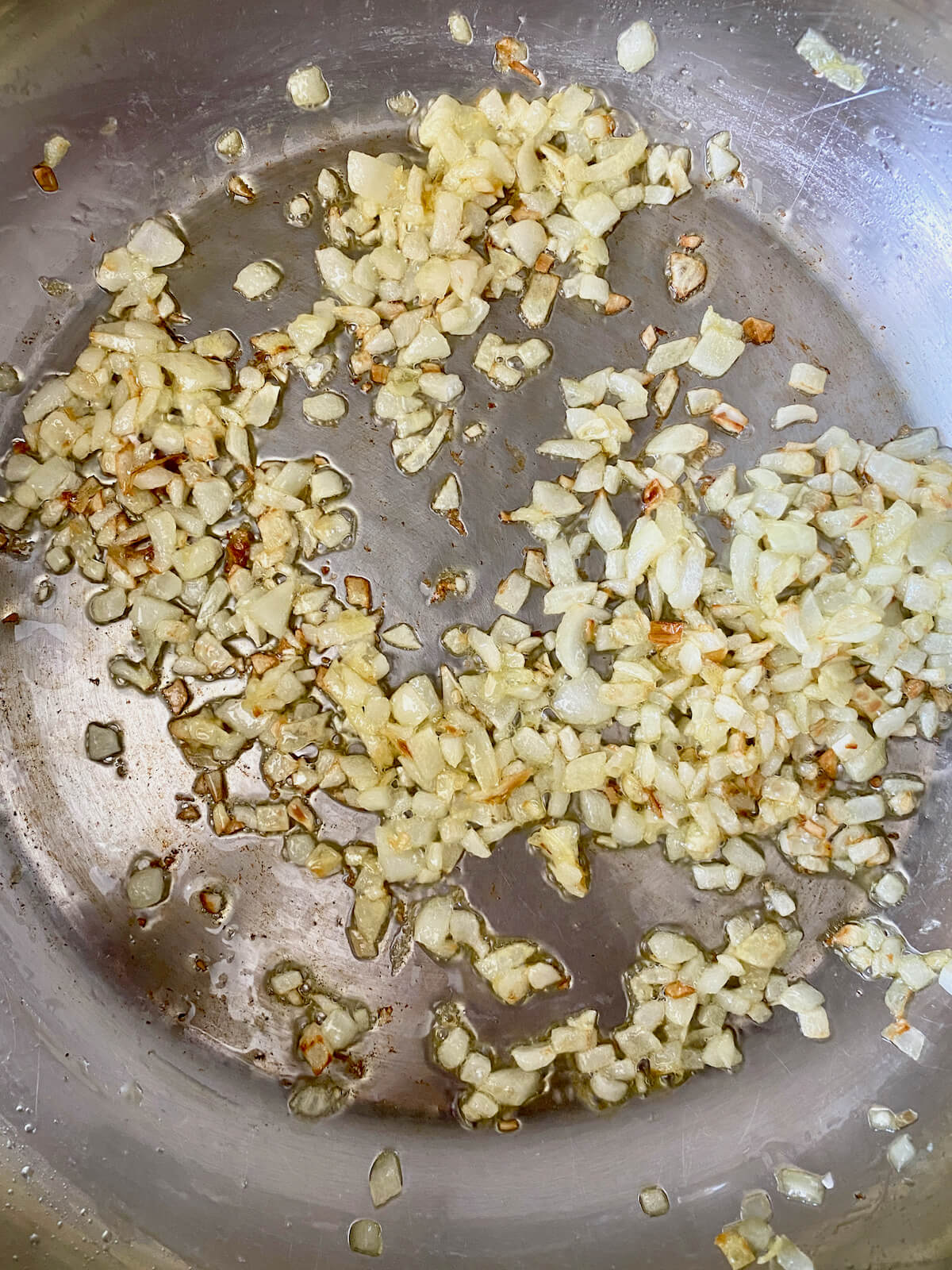
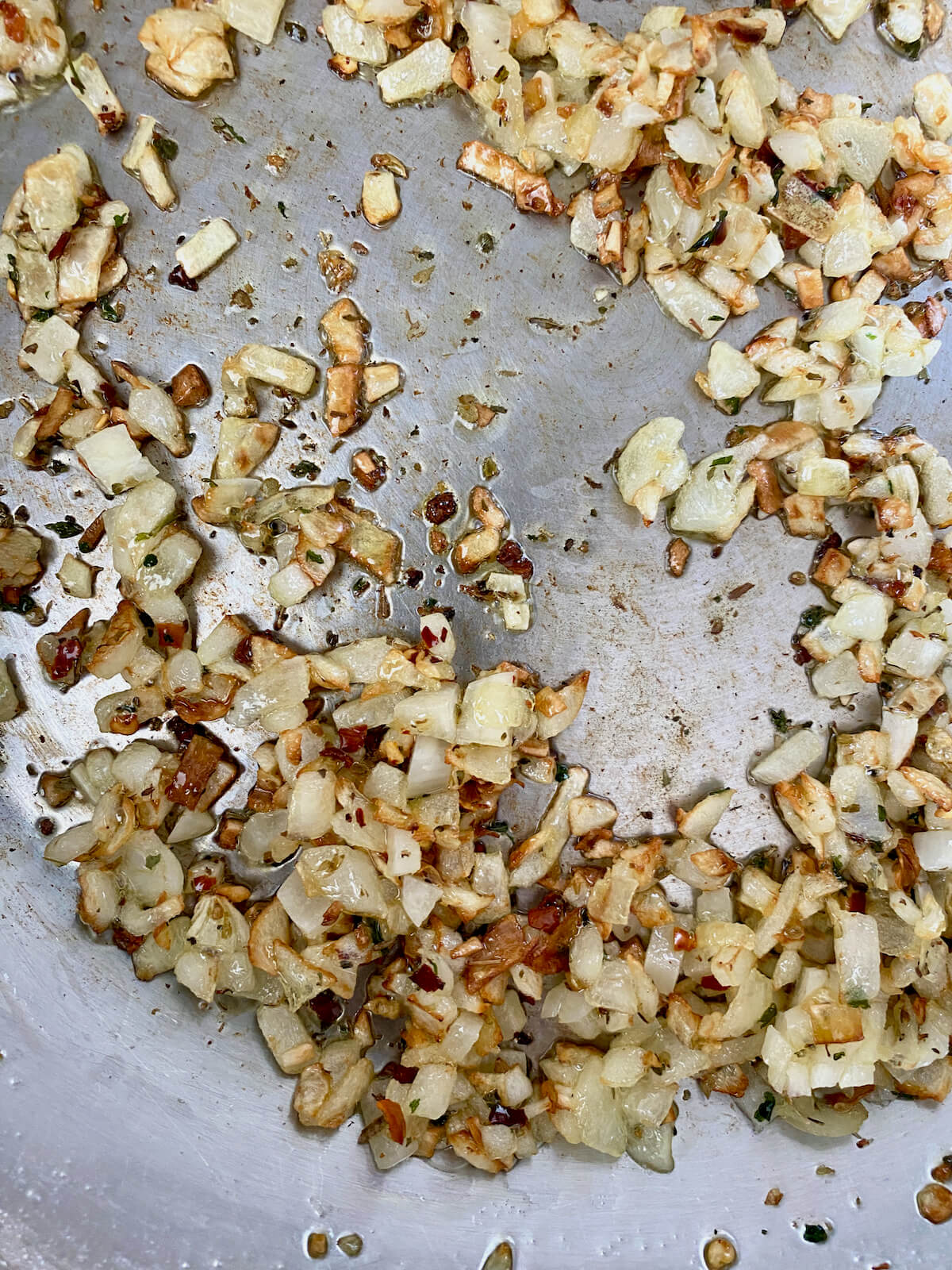
Step 3: Add tomatoes. Add the canned San Marzano tomatoes to the pot. Use a wooden spoon to start breaking up the tomatoes to release their juices.
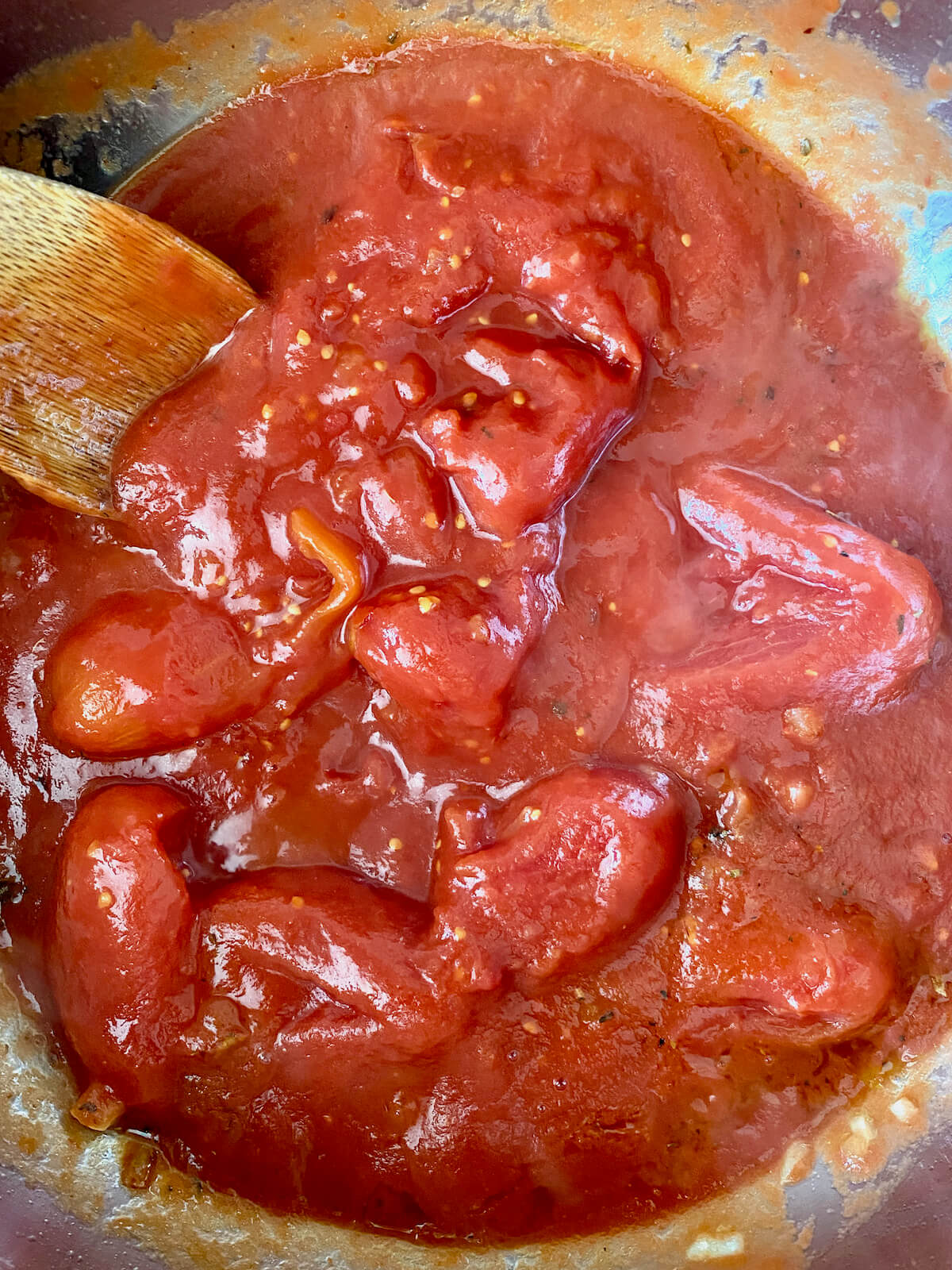
Step 4: Simmer the sauce. Bring the sauce to a gentle simmer, then reduce the heat to low. Cover the pot with a lid and let the tomatoes simmer for 20-30 minutes or until they are tender.
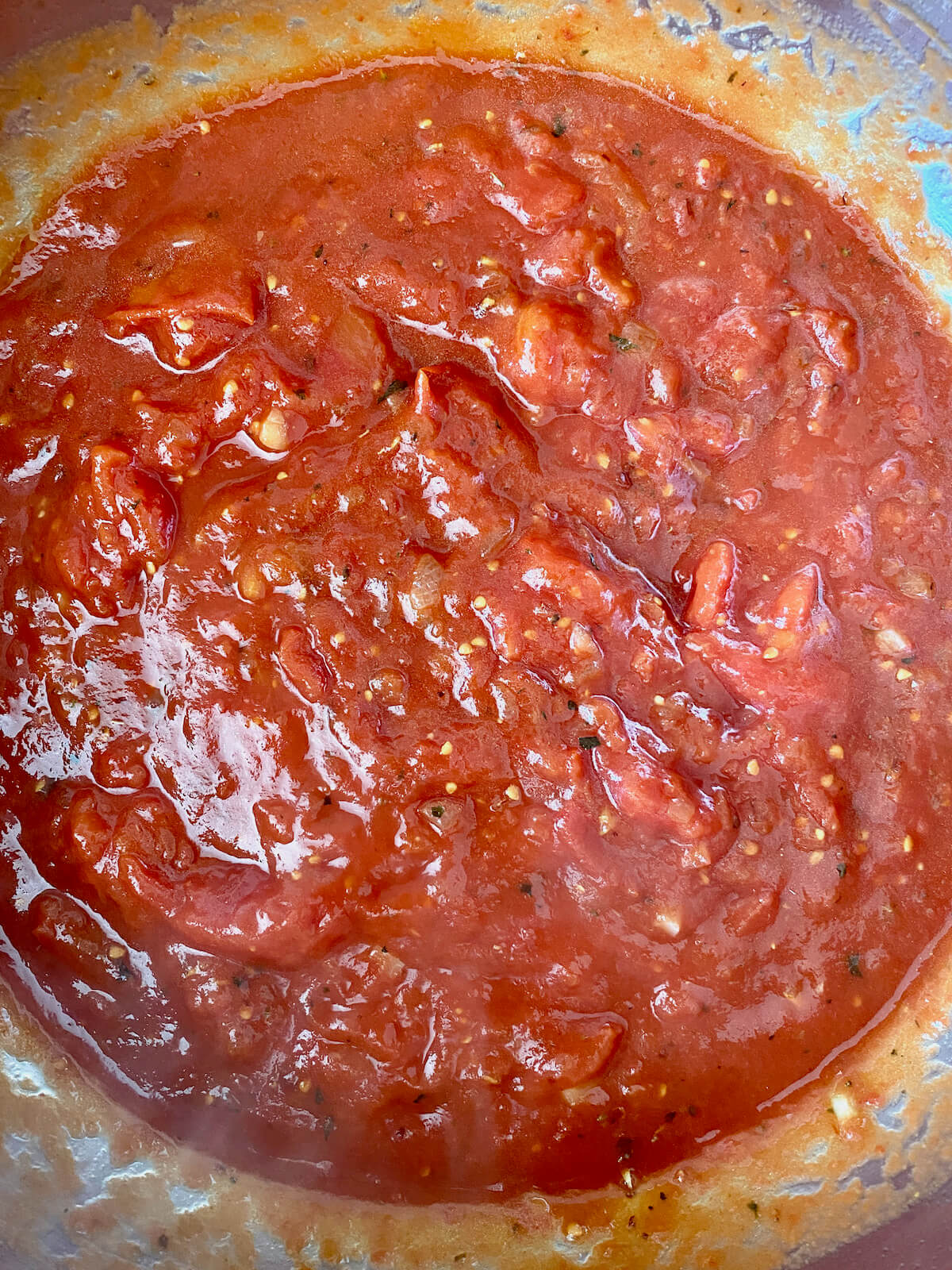
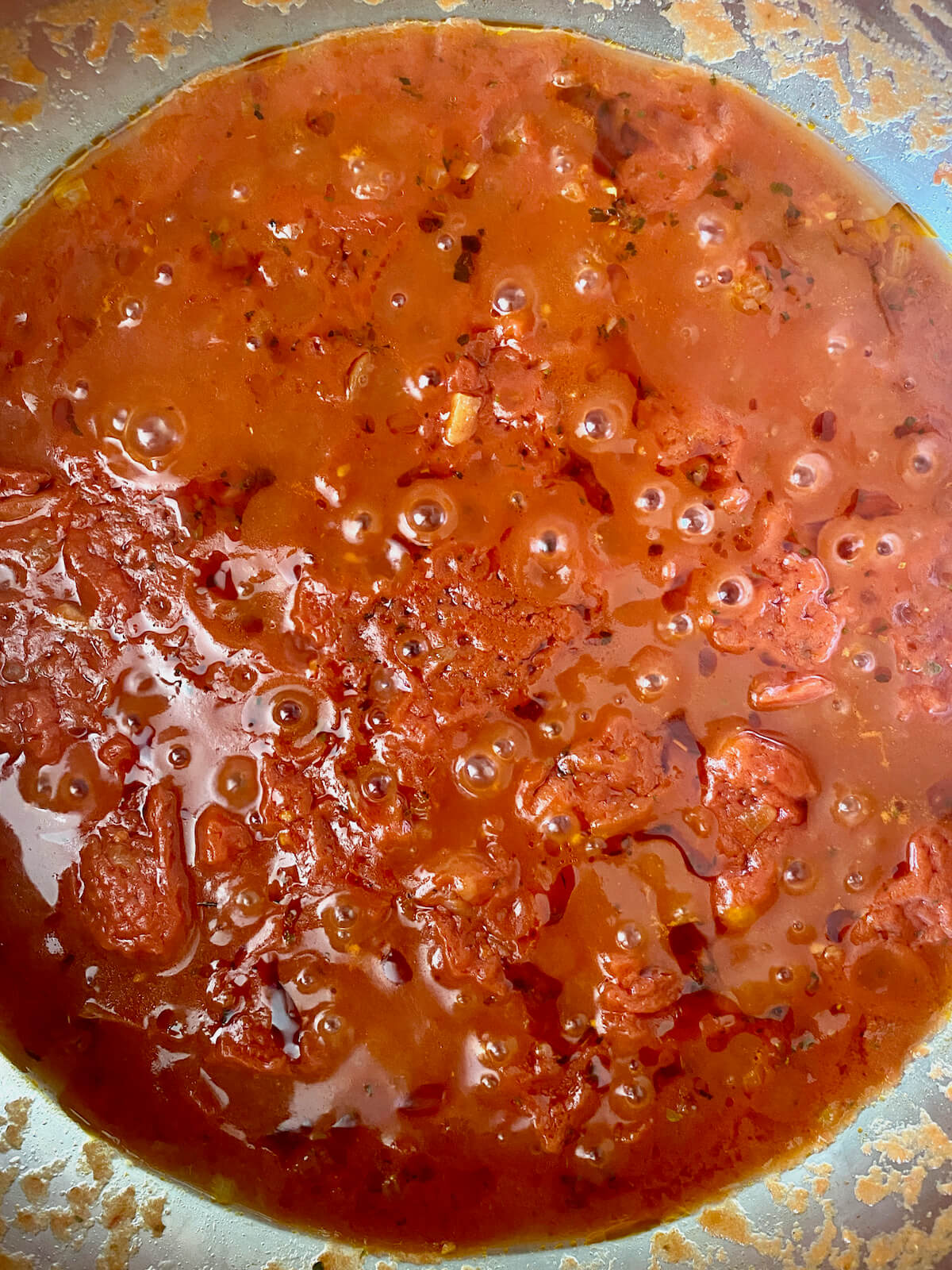
Step 5: Puree the sauce. Once the tomatoes are tender, you can blend the sauce using an immersion blender directly in the pot or carefully transfer the sauce to a regular blender and puree it in batches. Alternatively, use the back of a wooden spoon to crush the tomatoes for a chunkier texture.
Step 6: Thicken the sauce (optional). If you prefer a thicker tomato sauce, heat it back up to a gentle simmer after pureeing. Cook uncovered for an additional 20 minutes or until the sauce reaches your desired thickness. Keep in mind that longer simmering will result in a thicker sauce.
Step 7: Serve. Taste and adjust the seasoning if needed. Serve with pasta, pizza, meatballs, or as a marinara dip. Enjoy!
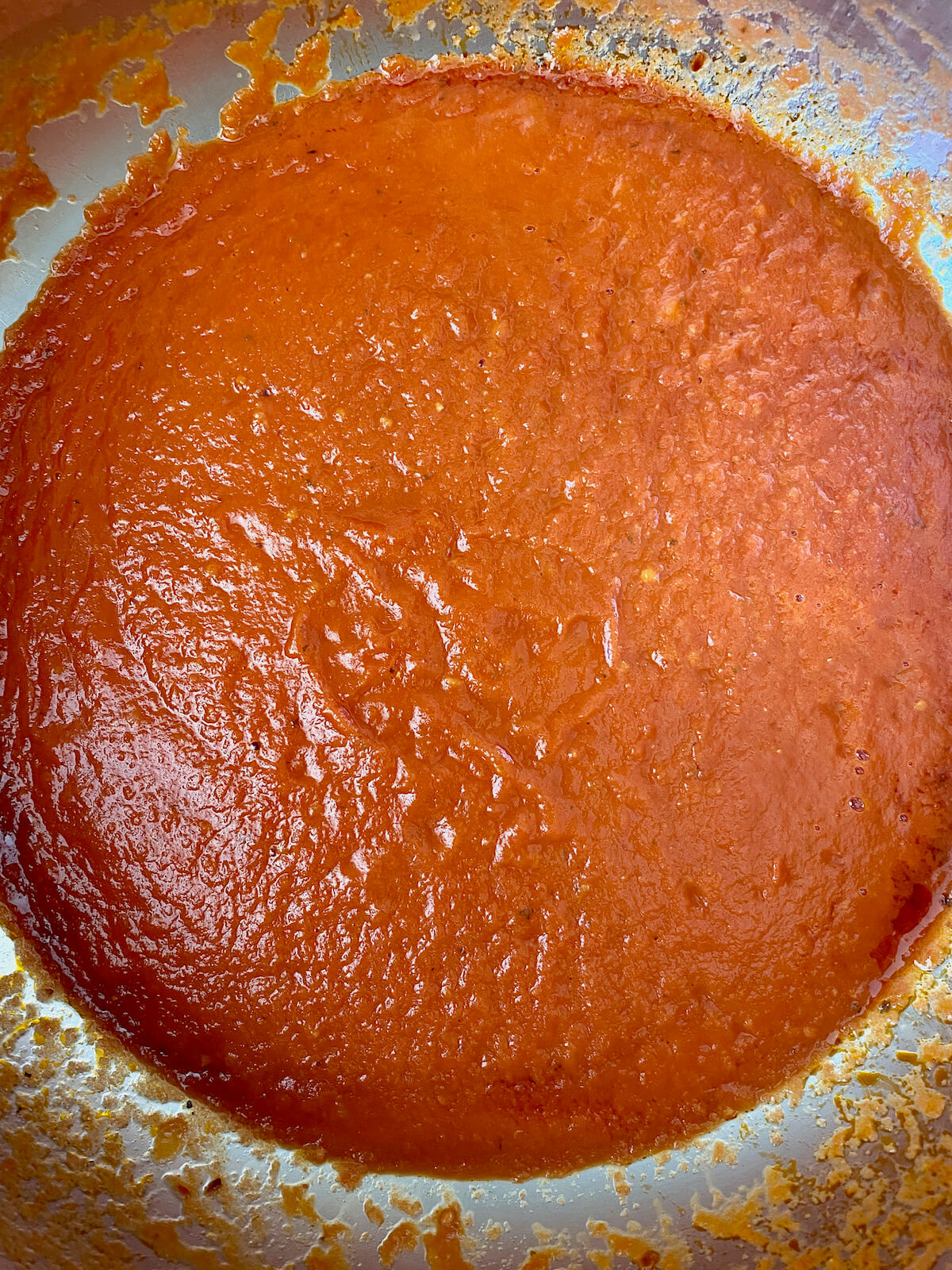
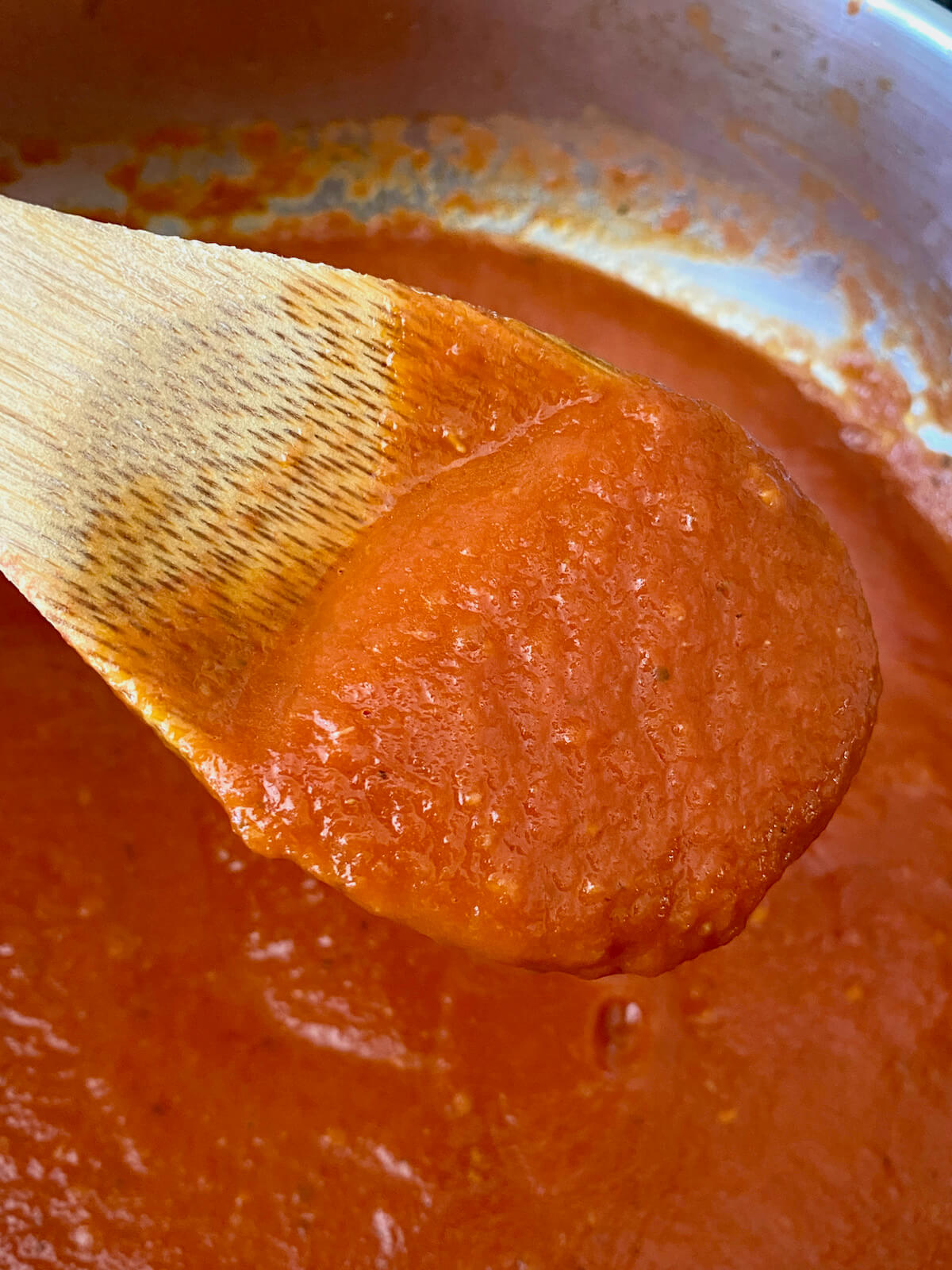
San Marzano Tomato Sauce (Video)
Tips for Success
Make this San Marzano pasta sauce successfully the first time using these easy kitchen tips.
- Choose high-quality ingredients. Since this tomato sauce made with San Marzano tomatoes relies on just a few simple ingredients, prioritize using the highest quality options available for the best flavor.
- Simmer gently. Boiling or simmering the sauce too vigorously can cause it to scorch on the bottom. Simmer the sauce gently to develop a richer flavor.
- Blend to your preferred texture. Adjust the texture by pureeing until smooth with a blender or using a wooden spoon for a chunkier sauce.
- Adjust the consistency. For recipes like San Marzano pizza sauce or chicken parmesan, opt for a slightly thicker sauce. A thinner sauce works well for dishes like meatballs or spaghetti.
- Season to taste. Taste the sauce before serving and adjust the seasoning if needed.
- Have fun and get creative. Enjoy the process of making homemade tomato sauce. Don't worry if it doesn’t turn out perfect the first time. And feel free to make the recipe your own!
What to Serve with San Marzano Tomato Sauce
This San Marzano tomato sauce can be used as the foundation for many delicious dishes. From classics like spaghetti and meatballs to homemade lasagna, mastering this basic tomato sauce recipe will help you become a more versatile home cook.
Naturally, marinara sauce is used in a variety of classic Italian dishes. This tomato sauce pairs well with sourdough pasta, meatballs, and lasagna. I also use it to make dishes like stuffed peppers and portobello stuffed mushrooms.
Making homemade pizza is another great way to use this easy San Marzano tomato sauce. Try making a delicious mushroom pizza with it, or use it as a base for your own pizza using either this sourdough discard pizza dough or this 72-hour pizza dough recipe on pizza night.
Finally, serve this marinara sauce as a zesty dipping sauce for bread and other appetizers. Some of my favorite foods to dip in this marinara sauce include sourdough discard garlic knots, sourdough breadsticks, garlic bread, sourdough bread, eggplant calzone, and cheesy broccoli bites.
Storage and Reheating
How to Store
- Refrigerator- Store leftover San Marzano tomato sauce in an airtight container in the refrigerator for 4-5 days.
- Freezer- To freeze, allow the sauce to cool completely before transferring it to a freezer-safe container or resealable bag. Store it in the freezer for up to 6 months.
🥫 Storage Tip: Make a large batch and freeze half for later. Divide the sauce into portion-sized containers and use it to make quick and easy dinners throughout the week.
Canning Homemade San Marzano Tomato Sauce
Interested in canning your homemade San Marzano tomato sauce?
You've got two options: pressure canning or water bath canning.
Since San Marzano tomatoes are lower in acidity, pressure canning is recommended for safety. Follow your pressure canner’s instructions for tomato sauce canning.
No pressure canner? No problem. Add 1 tablespoon of lemon juice per pint to increase the acidity, then boil the jars in a water bath for 35 minutes.
Following proper canning techniques is essential to ensure the safety and longevity of your preserved sauce. Be sure to consult reliable canning resources, such as the USDA Complete Guide to Home Canning.
This recipe yields about 3 pint-sized jars.
How to Reheat
If your sauce is frozen, allow it to thaw overnight in the refrigerator for best results.
- Stovetop- Transfer leftover tomato sauce to a saucepan set over medium-low heat. Heat the sauce, stirring occasionally, until warmed through.
- Microwave- Place leftover sauce in a microwave-safe bowl and cover it with a lid or plate to prevent splattering. Heat the sauce on half power (50%) for one minute. Stir, then continue heating in 30-second intervals until hot.
- Oven- Preheat oven to 325°F. Transfer the sauce to a baking dish and cover it with aluminum foil to prevent drying. Heat for 15-20 minutes or until the sauce is fully warmed through.
Make Ahead
Preparing this San Marzano tomato sauce in advance is a great time saver and something I do often. By making a batch in advance, you can save time on busy days and have a flavorful base ready for various dishes.
Simply prepare the sauce according to the recipe and store it in the refrigerator for up to 5 days or in the freezer for up to 6 months.
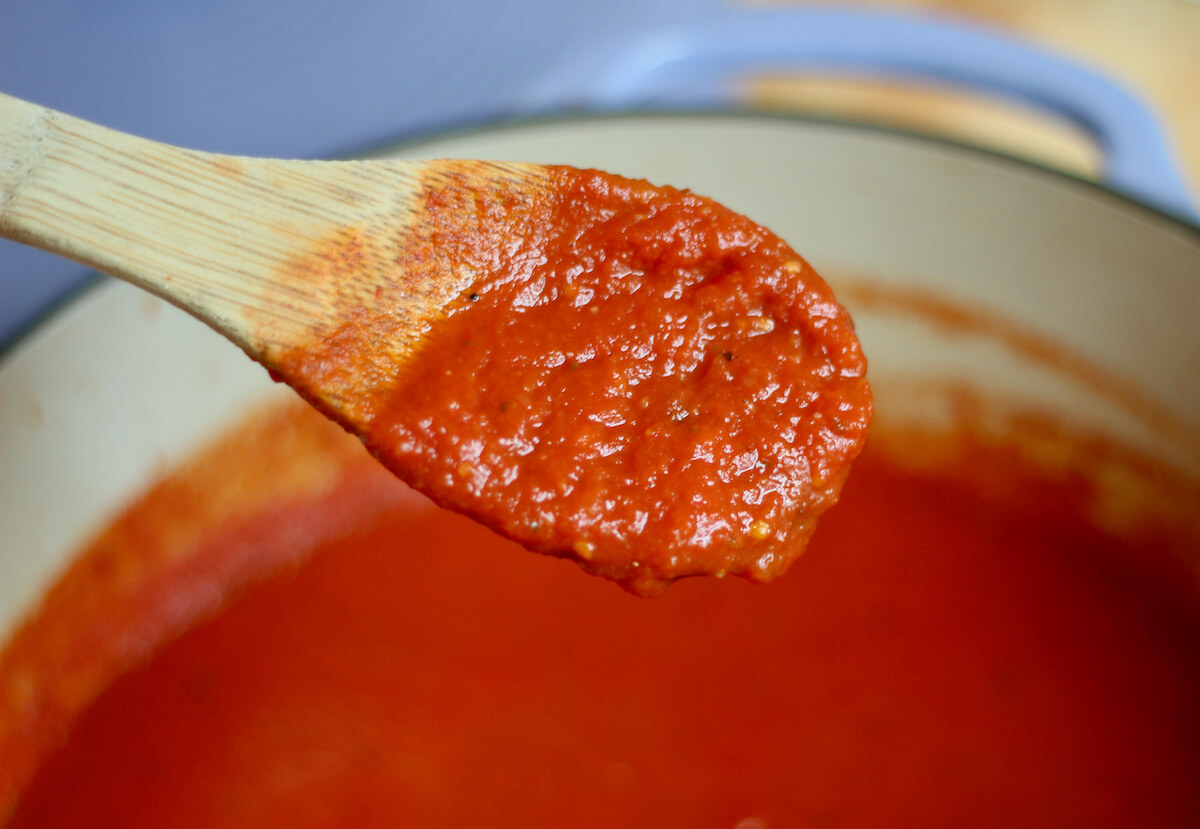
Frequently Asked Questions
San Marzano tomatoes are better for sauce because of their thick flesh, fewer seeds, and lower acidity. These characteristics yield a sweet, rich sauce with a lower water content, making them an ideal choice for flavorful tomato sauce.
San Marzano tomatoes and Roma tomatoes both belong to the plum tomato category, but San Marzano tomatoes are generally larger, have thinner skin, fewer seeds, and are sweeter with lower acidity.
Yes, you can use fresh tomato sauce with San Marzano tomatoes, but they need to be blanched and peeled first. To do this, make a small "X" on the bottom, boil them for 30 seconds, cool in ice water, peel, and use in the recipe. Note that the flavor and texture may differ slightly from using canned San Marzano tomatoes.
No, the San Marzano tomatoes' natural sweetness usually eliminates the need for added sugar in the sauce. However, if you find the sauce too acidic, you can balance it by adding a small amount of sugar or a drizzle of honey to taste. Adjust gradually and taste as you go.
If it's too thick, you can add a splash of water or broth to thin it. If it's too thin, simmer it uncovered for a bit longer to reduce the liquid content.
Let's Connect!
Be sure to leave a comment below if you have any questions. You can also connect with me on Instagram, Facebook, Pinterest, or via email at [email protected].
More Pasta Sauce Recipes
📖 Recipe
San Marzano Tomato Sauce
Equipment
- Immersion blender or blender optional
Ingredients
- 4 tablespoons extra virgin olive oil
- 1 large yellow onion diced
- 1 teaspoon kosher salt
- 4 cloves garlic minced
- ½ tablespoon Italian seasoning
- ¼-½ teaspoon red chili pepper flakes to taste
- 2 28-ounce cans San Marzano whole peeled tomatoes
Instructions
- Heat olive oil in a large Dutch oven or stainless steel pot over medium heat. Add the diced onion and kosher salt. Cook for 5-7 minutes until the onion is soft and just starting to turn golden.4 tablespoons extra virgin olive oil, 1 large yellow onion, 1 teaspoon kosher salt
- Stir in the minced garlic, Italian seasoning, and red chili pepper flakes. Cook for an additional 1-2 minutes to release the flavors.4 cloves garlic, ½ tablespoon Italian seasoning, ¼-½ teaspoon red chili pepper flakes
- Add the canned San Marzano tomatoes to the pot. Use a wooden spoon to start breaking up the tomatoes to release their juices.2 28-ounce cans San Marzano whole peeled tomatoes
- Bring the sauce to a gentle simmer, then reduce the heat to low. Cover the pot with a lid and let the tomatoes simmer for 20-30 minutes or until they are tender.
- Once the tomatoes are tender, you can blend the sauce using an immersion blender directly in the pot or carefully transfer the sauce to a regular blender and puree it in batches. Alternatively, use the back of a wooden spoon to crush the tomatoes for a chunkier texture.
- If you prefer a thicker tomato sauce, heat it back up to a gentle simmer after pureeing. Cook uncovered for an additional 20 minutes or until the sauce reaches your desired thickness. Keep in mind that longer simmering will result in a thicker sauce.
- Taste and adjust the seasoning if needed. Serve with pasta, pizza, meatballs, or as a marinara dip. Enjoy!
Notes
- Adjust the consistency. For recipes like pizza or chicken parmesan, opt for a slightly thicker sauce. A thinner sauce works well for dishes like meatballs or spaghetti.
- Storage: Store leftover tomato sauce in an airtight container in the refrigerator for up to 5 days or in the freezer for up to 6 months.

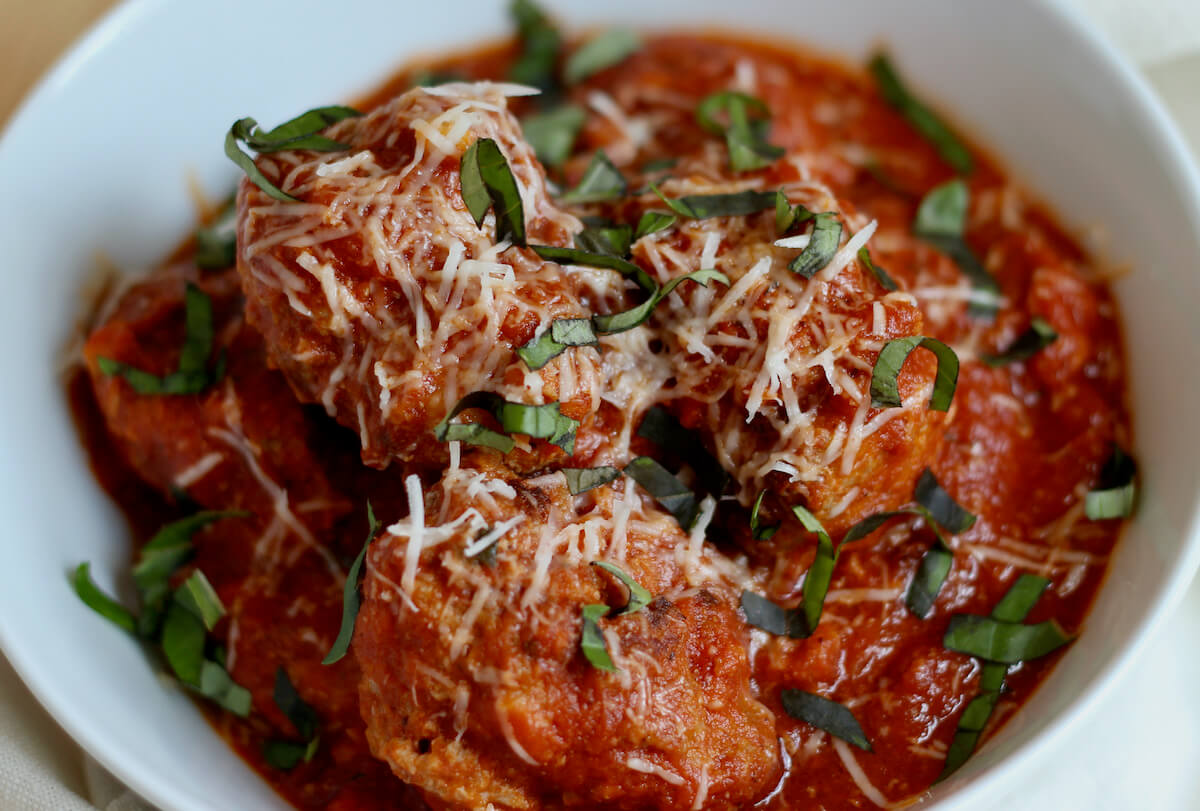
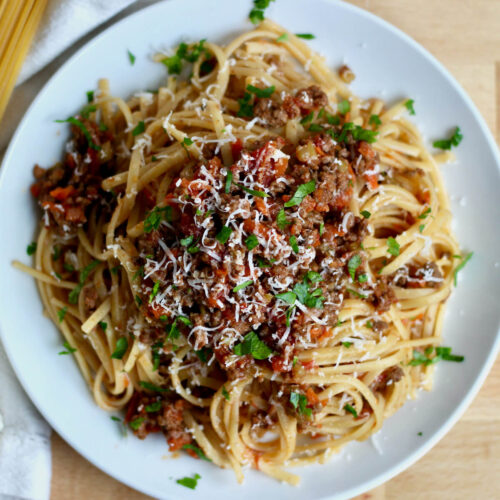

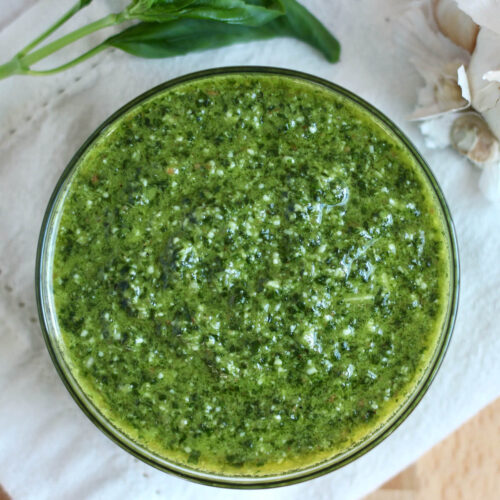




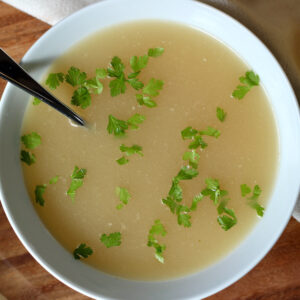

Comments
No Comments